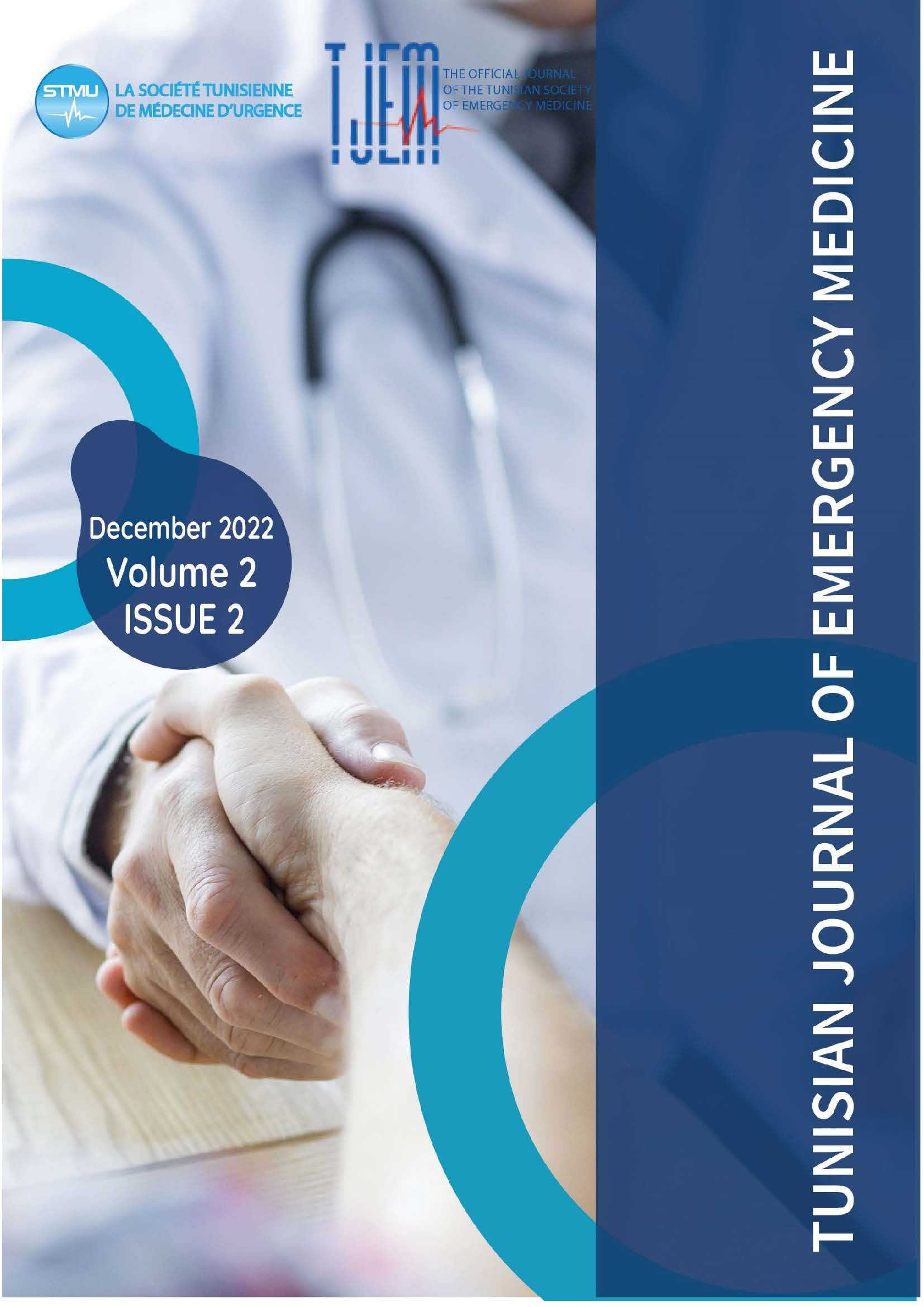Short and long-term outcomes of patients presenting with Acute Coronary Syndrome without ST-segment elevation (NSTE -ACS): findings from a Tunisian Register: the ReSCUS Register
Rahma JABALLAH, Hajer YAAKOUBI; Lotfi BOUKADIDA; Rym YOUSSEF; A BACCARI; Asma ZORGATI; Riadh BOUKEF
DOI:
https://doi.org/10.0000/p3kcxj09Keywords:
Acute coronary syndrome;, Emergency department, Management, DelayAbstract
Background: Chest pain is one of the most common complaints in the emergency department. Acute coronary syndrome with ST-segment elevation remains the ultimate medical emergency. However, acute coronary syndrome without ST-segment elevation (NSTE -ACS) has an equivalent prognosis risk. The major challenge of the emergency physician is the rapid and accurate identification of patients with ACS who would benefit from immediate care.
Objective:
Evaluation of our practices according to European Recommendations for the management of NSTEACS and assessment of short and long-term prognosis for major cardiovascular events (MACE).
Methods: This is an analytical study, involving 850 patients treated for NSTE-ACS for 2 years in the emergency department. Data were collected from the acute coronary syndromes’ local register (ReSCUS register). The main results were: the different delays in medical care, length of stay in the emergency department, short-term complications, and the occurrence of MACE registered at one month, six months, and one year later.
Results: The average age of our patients was 64 +/- 11 years. The sex ratio was 2.2. Hypertension and diabetes are the two most common risk factors in our population. NSTE-ACS was inaugural in almost a third of the cases. Only 7% of the patients have been referred to the ED by a medical team.
In 16.2% of cases, the initial ECG found no repolarization disorder. The average first medical contact delay was 24.4 +/- 30.2 min. The average first qualifying ECG delay was 30 +/- 0.6 min. The average length of stay in the emergency department before admission to the cardiology department was 24.1 +/- 21.3 hours. More than half of the sample (68%) had their angiograms within 48 hours. Among the 500 followed-up patients, 12 were completely lost. Patients who presented at least one MACE were
at one month: 58 patients (11.6%) at 6 months: 112 patients (22.4%), and at 1 year 136 patients (27.2%).
Conclusion: Cardiovascular disease is the leading cause of death worldwide. Assessment of our practices is important to improve prognosis. Registers offer a guarantee of methodology and are a real mirror of our medical care.
Downloads
Published
Issue
Section
License
Copyright (c) 2022 Tunisian Journal of Emergency Medicine

This work is licensed under a Creative Commons Attribution-NonCommercial-ShareAlike 4.0 International License.
How to Cite
Similar Articles
- Sondes laajimi, haifa bradai, Nabil Chebbi, Dorra Loghmari , imen EL KISSI, Naoufel Chebili , rabeb Mbarek, Specific Features of Chest Pain in Young People treated in Prehospital Care , Tunisian Journal of Emergency Medicine: Vol. 3 No. 1 (2025): TJEM 2025: Vol.3 Issue 1
- Amira Sghaier, Marwa Toumia, Khaoula Bel Haj Ali, Adel Sekma, Kaouthar Beltaief, Zied Mezgar, Wahid Bouida, Riadh Boukef, Jamel Saad, Hamdi Boubaker, Mohamed Amine Msolli, Mohamed Habib Grissa, Semir Nouira, B-lines Ultrasonography Assessment by Nurses for the Diagnosis of Heart Failure in the Emergency Department , Tunisian Journal of Emergency Medicine: Vol. 2 No. 4 (2024): TJEM Vol2 Issue4
- Sarra Akkari , Emna Rachdi , Jalila Ben Khlil , Prognosis in COVID-19: Impact of Pre-hospital Emergency Care , Tunisian Journal of Emergency Medicine: Vol. 2 No. 4 (2024): TJEM Vol2 Issue4
- Samia Meherzi, Rihab Omri, Amin khbou , Rabiaa Kaddechi , Afifa CHARFI, Management of Bell palsy: our clinical practice guideline , Tunisian Journal of Emergency Medicine: Vol. 3 No. 1 (2025): TJEM 2025: Vol.3 Issue 1
- Lassaad CHTOUROU, Jejunal Diverticulosis: Review , Tunisian Journal of Emergency Medicine: Vol. 2 No. 4 (2024): TJEM Vol2 Issue4
- Fatma Hbaieb, Low Back Pain Revealing Bilateral ProximalPulmonary Embolism with COVID-19 , Tunisian Journal of Emergency Medicine: Vol. 2 No. 4 (2024): TJEM Vol2 Issue4
- Rabeb Mbarek, Khouloud Hamdi, Sarra Soua, Hela Abroug, Sondes laajimi, haifa Bradai, Dorra Loghmari , Asma SRIHA, Semir Nouira, Prehospital Particularities of Covid-19 infection and factors associated with its severity during the omicron variant wave (East-center of Tunisia) , Tunisian Journal of Emergency Medicine: Vol. 2 No. 4 (2024): TJEM Vol2 Issue4
- Rania Hammami, Syrine Triki, Aimen Dammak, Faiza Safi, Olfa Chakroun , An abrupt cardiogenic shock in a female at the era of COVID 19 pandemic lockdown , Tunisian Journal of Emergency Medicine: Vol. 3 No. 1 (2025): TJEM 2025: Vol.3 Issue 1
- Haifa BRADAÏ, Rabeb Mbarek, Sondes Laajimi, Dorra Loghmari, Mounir NAIJA, Atrial flutter mimicking ST-elevation myocardial infarction: A case report , Tunisian Journal of Emergency Medicine: Vol. 3 No. 1 (2025): TJEM 2025: Vol.3 Issue 1
- safia othmani, Ischemic acute cholecystitis: a case report , Tunisian Journal of Emergency Medicine: Vol. 2 No. 4 (2024): TJEM Vol2 Issue4
You may also start an advanced similarity search for this article.

